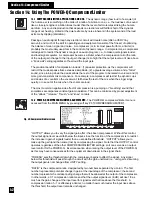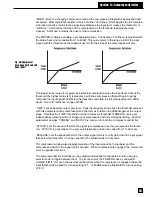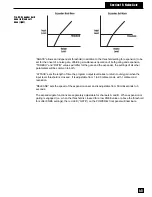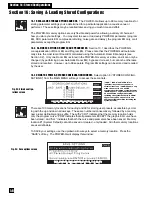
14.1 COMPRESSOR/LIMITER APPLICATIONS AND USE.
The dynamic range (how loud to how quiet) of
the human ear is something on the order of a ratio of a billion to one; i.e., the loudness of a sound
like a close jet engine is a billion times louder than the level of air molecules striking the human
eardrum. Any sound reproduction that depends on electronics will fall far short of the dynamic
range of our hearing, limited at the quiet extreme by noise inherent in the system and at the loud
extreme by clipping (distortion).
Passing an audio signal through any electronic circuit will create noise (often a VERY tiny
amount), and much of the skill in operating sound equipment consists of the fine art of optimizing
the balance of clean signal and noise. A compressor (or, in its most powerful form, a limiter) is
probably the most widely used tool in the control of dynamic range. In simple terms, a compressor
is designed to restrict the dynamic range of an audio program; i.e., to make quiet signals louder,
and loud signals quieter. A compressor becomes a limiter when the compression ratio (the ratio
of the output gain change to the input gain change) is so high that the output level won’t rise above
a “brick wall” ceiling regardless of how loud the input gets.
The practical benefits of compression include: (1) speaker protection, as the compressor will
restrict the musical peaks from excessive amplitude; (2) a greater average volume and a “fatter”
sound, since turning down the peaks allows the rest of the program to be raised in volume; and (3)
more gain-consistent mix components. For example, a compressor will restrict the dynamic ups
and downs of a vocalist so the vocal won’t fall below the rest of the mix when the singer sings
quietly, or rise out of the mix when the vocals are loud.
The most common negative side effect of compression is a pumping or “breathing” sound that
sometimes accompanies constant gain modulation. This can be minimized by proper adjustment
of the “attack,” “release,” “thresh,” and “knee” controls.
14.2 POWER-Q COMPRESSOR/LIMITER ADJUSTMENTS.
The POWER-Q compressor/limiter menu is
accessed from the MAIN MENU by pressing soft key #5 (“COMPRESSOR/LIMITER”).
“OUTPUT” allows you to vary the signal gain after it has been compressed. Without this control,
the output signal level would fall below the input, since the function of the compressor is to restrict
the increase in gain of signals louder than a user-defined threshold. “OUTPUT” allows you to
make up the gain (and then some) lost by compressing the signal. Note that the OUTPUT control
operates regardless of the other COMPRESSOR/LIMITER settings, so it can serve as an output
level control for the POWER-Q. Exercise caution when raising the output level of the POWER-Q,
as this may have consequences for the equipment downstream in the signal chain.
“THRESH” sets the threshold at which the compressor begins to affect the signal. Any signal
below this threshold will pass through the circuit with the gain unaltered (i.e., unity gain), assuming
the output gain is not changed from UNITY setting.
“RATIO” is the compression ratio, designated by two numbers separated by a colon. The first
number represents a potential change in gain at the input stage of the compressor; the second
number represents the corresponding change that will be allowed at the output of the compressor.
In other words, a 3:1 compression ratio means that the output signal level (in dB) will rise 1/3 as
much as the gain change at the input level for signal levels that rise above the threshold. A
compression ratio of
4
:1 is effectively a limiter; no matter how much louder the input rises above
the threshold, the output level remains unchanged.
42
Section 14: Compressor/Limiter
Section 14: Using The POWER-Q Compressor/Limiter
Fig. 49: Compressor/limiter screen
















































